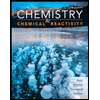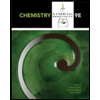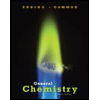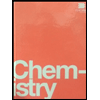
Introductory Chemistry: Foundation - Text (Looseleaf)
9th Edition
ISBN: 9781337399623
Author: ZUMDAHL
Publisher: Cengage
expand_more
expand_more
format_list_bulleted
Concept explainers
Textbook Question
Chapter 15.4, Problem 15.4SC
ercise 15.4 Give the concentrations of the ions in each of the following solutions:
10 M Na2CO3
0 10 M Al2(SO4) 3
Expert Solution & Answer
Want to see the full answer?
Check out a sample textbook solution
Students have asked these similar questions
A chemical engineer is studying the two reactions shown in the table below.
In each case, she fills a reaction vessel with some mixture of the reactants and products at a constant temperature of 70.0 °C and constant total pressure.
Then, she measures the reaction enthalpy AH and reaction entropy AS of the first reaction, and the reaction enthalpy AH and reaction free energy AG of the
second reaction. The results of her measurements are shown in the table.
Complete the table. That is, calculate AG for the first reaction and AS for the second. (Round your answer to zero decimal places.) Then, decide whether, under
the conditions the engineer has set up, the reaction is spontaneous, the reverse reaction is spontaneous, or neither forward nor reverse reaction is spontaneous
because the system is at equilibrium.
-
P₁ (s) + 20HF (g). 4PF, (g) + 10H2(g)
AH-1005. kJ
J
AS 2929.
K
AG =
0 kJ
Which is spontaneous?
this reaction
the reverse reaction
neither
AH = 12. kJ
+0=
AS =
SnO2 (s) + 2CO(g) →…
A chemist fills a reaction vessel with 0.281 g silver chromate (Ag₂CrO4) solid, 0.710 M silver (Ag*) aqueous solution, and 0.985 M chromate (CrO2-)
aqueous solution at a temperature of 25.0°C.
Under these conditions, calculate the reaction free energy AG for the following chemical reaction:
Ag2CrO4(s) 2Ag(aq) + CrO4(aq)
Use the thermodynamic information in the ALEKS Data tab. Round your answer to the nearest kilojoule.
4
☐ kJ
x
Draw the structure corresponding to each IUPAC name.
Part 1 of 2
A skeletal structure corresponding to the IUPAC name 3-ethylhexane.
Click and drag to start drawing a
structure.
Chapter 15 Solutions
Introductory Chemistry: Foundation - Text (Looseleaf)
Ch. 15.3 - ercise 15.1 A 1 35-g sample of seawater is...Ch. 15.3 - Prob. 15.2SCCh. 15.4 - ercise 15.3 Calculate the molarity of a solution...Ch. 15.4 - ercise 15.4 Give the concentrations of the ions in...Ch. 15.4 - ercise 15.5 Calculate the number of moles of Cl...Ch. 15.4 - ercise 15.6 Formalin is an aqueous solution of...Ch. 15.5 - ercise 15.7 What volume of 12 M HCI must be taken...Ch. 15.6 - at if all ionic solids were soluble in water? How...Ch. 15.6 - Exercise 15.8 When aqueous solutions of Na2SO3 and...Ch. 15.7 - ercise 15.9 Calculate the volume of 0.10 M HNO3...
Ch. 15.8 - ercise 15.10 Calculate the normality of a solution...Ch. 15.8 - Prob. 15.11SCCh. 15 - ou have a solution of table sail in water. What...Ch. 15 - onsider a sugar solution (solution A) with...Ch. 15 - You need to make 150.0 mL of a 0.10 M NaCI...Ch. 15 - ou have two solutions containing solute A. To...Ch. 15 - m>5. Which of the following do you need to know to...Ch. 15 - onsider separate aqueous solutions of HCI and...Ch. 15 - Prob. 7ALQCh. 15 - an one solution have a greater concentration than...Ch. 15 - Prob. 9ALQCh. 15 - You have equal masses of different solutes...Ch. 15 - Which of the following solutions contains the...Ch. 15 - As with all quantitative problems in chemistry,...Ch. 15 - Prob. 13ALQCh. 15 - Prob. 14ALQCh. 15 - solution is a homogeneous mixture. Can you give an...Ch. 15 - ow do the properties of a nonhomogeneous...Ch. 15 - Prob. 3QAPCh. 15 - Prob. 4QAPCh. 15 - n Chapter 14. you learned that the bonding forces...Ch. 15 - n oil spill spreads out on the surface of water,...Ch. 15 - . The “Chemistry in Focus” segment Water, Water...Ch. 15 - Prob. 8QAPCh. 15 - Prob. 9QAPCh. 15 - Prob. 10QAPCh. 15 - A solution is a homogeneous mixture and, unlike a...Ch. 15 - Prob. 12QAPCh. 15 - How do we define the mass percent composition of a...Ch. 15 - Prob. 14QAPCh. 15 - Calculate the percent by mass of solute in each of...Ch. 15 - Calculate the percent by mass of solute in each of...Ch. 15 - Prob. 17QAPCh. 15 - Prob. 18QAPCh. 15 - A sample of an iron alloy contains 92.1 g Fe. 2.59...Ch. 15 - Consider the iron alloy described in Question 19....Ch. 15 - An aqueous solution is to be prepared that will be...Ch. 15 - Prob. 22QAPCh. 15 - A solution is to be prepared that will be 4.50% by...Ch. 15 - Prob. 24QAPCh. 15 - Prob. 25QAPCh. 15 - Hydrogen peroxide solutions sold in drugstores as...Ch. 15 - Prob. 27QAPCh. 15 - A solvent sold for use in the laboratory contains...Ch. 15 - Prob. 29QAPCh. 15 - A solution labeled “0.25 M AICl3” would contain...Ch. 15 - What is a standard solution? Describe the steps...Ch. 15 - Prob. 32QAPCh. 15 - 33. For each of the following solutions, the...Ch. 15 - 34. For each of the following solutions, the...Ch. 15 - 35. For each of the following solutions, the mass...Ch. 15 - Prob. 36QAPCh. 15 - 37. A laboratory assistant needs to prepare 225 mL...Ch. 15 - Prob. 38QAPCh. 15 - 39. Standard solutions of calcium ion used to test...Ch. 15 - Prob. 40QAPCh. 15 - 41. If 42.5 g of NaOH is dissolved in water and...Ch. 15 - 42. Standard silver nitrate solutions are used in...Ch. 15 - Prob. 43QAPCh. 15 - Prob. 44QAPCh. 15 - Prob. 45QAPCh. 15 - Prob. 46QAPCh. 15 - Prob. 47QAPCh. 15 - 48. What mass of solute is present in 225 mL of...Ch. 15 - Prob. 49QAPCh. 15 - Prob. 50QAPCh. 15 - Prob. 51QAPCh. 15 - 52. What volume of a 0.300 M CaCl2 solution is...Ch. 15 - Prob. 53QAPCh. 15 - Prob. 54QAPCh. 15 - Prob. 55QAPCh. 15 - Prob. 56QAPCh. 15 - Prob. 57QAPCh. 15 - Prob. 58QAPCh. 15 - Prob. 59QAPCh. 15 - 60. Suppose 325 in L of 0.150 M NaOH is needed for...Ch. 15 - 61. How much water must be added w 500. mL of...Ch. 15 - Prob. 62QAPCh. 15 - Prob. 63QAPCh. 15 - 64. Generally only the carbonates of the Group I...Ch. 15 - 65. Many metal ions are precipitated from solution...Ch. 15 - 66. Calcium oxalate, CaCO4, is very insoluble in...Ch. 15 - 67. When aqueous solutions of lead(II) ion are...Ch. 15 - 68. Aluminum ion may be precipitated from aqueous...Ch. 15 - 69. What volume of 0.502 M NaOH solution would be...Ch. 15 - 70. What volume of a 0.500 M NaOH solution would...Ch. 15 - 71. A sample of sodium hydrogen carbonate solid...Ch. 15 - 72. The total acidity in water samples can be...Ch. 15 - Prob. 73QAPCh. 15 - Prob. 74QAPCh. 15 - Prob. 75QAPCh. 15 - Prob. 76QAPCh. 15 - 77. Explain why the equivalent weight of H2SO4 is...Ch. 15 - Prob. 78QAPCh. 15 - Prob. 79QAPCh. 15 - Prob. 80QAPCh. 15 - Prob. 81QAPCh. 15 - Prob. 82QAPCh. 15 - Prob. 83QAPCh. 15 - Prob. 84QAPCh. 15 - 85. How many milliliters of 0.50 N NaOH are...Ch. 15 - 86. What volume of 0.104 N H2SO4is required to...Ch. 15 - 87. What volume of 0.151 N NaOH is required to...Ch. 15 - Prob. 88QAPCh. 15 - 89. A mixture is prepared by mixing 50.0 g of...Ch. 15 - Prob. 90APCh. 15 - 91. Suppose 50.0 mL of 0.250 M CoCl2 solution is...Ch. 15 - Prob. 92APCh. 15 - 93. Calculate the mass of AgCl formed, and the...Ch. 15 - 94. Baking soda (sodium hydrogen carbonate....Ch. 15 - 95. Many metal ions form insoluble sulfide...Ch. 15 - Prob. 96APCh. 15 - Prob. 97APCh. 15 - Prob. 98APCh. 15 - Prob. 99APCh. 15 - Prob. 100APCh. 15 - Prob. 101APCh. 15 - You mix 225.0 mL of a 2.5 M HCl solution with...Ch. 15 - A solution is 0.1% by mass calcium chloride....Ch. 15 - Prob. 104APCh. 15 - Prob. 105APCh. 15 - A certain grade of steel is made by dissolving 5.0...Ch. 15 - Prob. 107APCh. 15 - Prob. 108APCh. 15 - Prob. 109APCh. 15 - Prob. 110APCh. 15 - How many moles of each ion are present in 11.7 mL...Ch. 15 - Prob. 112APCh. 15 - Prob. 113APCh. 15 - Prob. 114APCh. 15 - Concentrated hydrochloric acid is made by pumping...Ch. 15 - Prob. 116APCh. 15 - Prob. 117APCh. 15 - Prob. 118APCh. 15 - If 10. g of AgNO3 is available, what volume of...Ch. 15 - Prob. 120APCh. 15 - Calcium carbonate, CaCO3, can be obtained in a...Ch. 15 - Prob. 122APCh. 15 - How many milliliters of 18.0 M H2SO4 are required...Ch. 15 - Consider the reaction between 1.0 L of 3.0 M...Ch. 15 - When 10. L of water is added to 3.0 L of 6.0 M...Ch. 15 - Prob. 126APCh. 15 - How many grams of Ba (NO3)2are required to...Ch. 15 - Prob. 128APCh. 15 - What volume of 0.250 M HCI is required to...Ch. 15 - Prob. 130APCh. 15 - Prob. 131APCh. 15 - Prob. 132APCh. 15 - How many milliliters of 0.105 M NaOH are required...Ch. 15 - Prob. 134APCh. 15 - Prob. 135APCh. 15 - Consider the reaction between 0.156 L of 0.105 M...Ch. 15 - Prob. 137CPCh. 15 - A solution is prepared by dissolving 0.6706 g of...Ch. 15 - What volume of 0.100 M NaOH is required to...Ch. 15 - Prob. 140CPCh. 15 - A 450.O-mL sample of a 0.257 M solution of silver...Ch. 15 - A 50.00-mL sample of aqueous Ca(OH)2 requires...Ch. 15 - When organic compounds containing sulfur are...Ch. 15 - Prob. 1CRCh. 15 - Prob. 2CRCh. 15 - Prob. 3CRCh. 15 - Prob. 4CRCh. 15 - Prob. 5CRCh. 15 - Prob. 6CRCh. 15 - Prob. 7CRCh. 15 - Prob. 8CRCh. 15 - Prob. 9CRCh. 15 - Prob. 10CRCh. 15 - Prob. 11CRCh. 15 - Without consulting your textbook, list and explain...Ch. 15 - What does “STP’ stand for? What conditions...Ch. 15 - Prob. 14CRCh. 15 - Prob. 15CRCh. 15 - Define the normal boiling point of water. Why does...Ch. 15 - Are changes in state physical or chemical changes?...Ch. 15 - Prob. 18CRCh. 15 - Prob. 19CRCh. 15 - Prob. 20CRCh. 15 - Define a crystalline solid. Describe in detail...Ch. 15 - Define the bonding that exists in metals and how...Ch. 15 - Prob. 23CRCh. 15 - Define a saturated solution. Does saturated mean...Ch. 15 - Prob. 25CRCh. 15 - When a solution is diluted by adding additional...Ch. 15 - Prob. 27CRCh. 15 - Prob. 28CRCh. 15 - Prob. 29CRCh. 15 - Prob. 30CRCh. 15 - Prob. 31CRCh. 15 - When calcium carbonate is heated strongly, it...Ch. 15 - If an electric current is passed through molten...Ch. 15 - Prob. 34CRCh. 15 - Prob. 35CRCh. 15 - Prob. 36CRCh. 15 - Prob. 37CRCh. 15 - Prob. 38CRCh. 15 - Prob. 39CRCh. 15 - Prob. 40CRCh. 15 - Prob. 41CRCh. 15 - 42. a. Fill in the following table as if it is a...
Knowledge Booster
Learn more about
Need a deep-dive on the concept behind this application? Look no further. Learn more about this topic, chemistry and related others by exploring similar questions and additional content below.Similar questions
- Using any data you can find in the ALEKS Data resource, calculate the equilibrium constant K at 25.0 °C for the following reaction. TiC₁₁(g) + 2H₂O(g) → TiO2 (s) + 4HCl (g) 4 Round your answer to 2 significant digits. K = ☐ x10 D Хarrow_forward: ☐ Х Draw an α amino acid with a hydroxyethyl (-CH2-CH2- OH) side chain. Draw the molecule as it would appear at physiological pH. Click and drag to start drawing a structure. 5 Parrow_forwardDraw the product of the reaction shown below. Ignore inorganic byproducts. cat. H2SO4 HNO3 (1 equiv) Drawing Qarrow_forward
- Provide the correct systematic name for the compound shown here.arrow_forwardUsing the appropriate bond energies, calculate the heat of reaction AH for the following reaction: H-H + CI-CI 2 H-CI You can find a table of bond energies by using the Data button on the ALEKS toolbar. Round your answer to the nearest kJ/mol. Note: For clarity, all lone pairs have been omitted from the molecular structures. ☐ kJ mol ค 000 Ar Barrow_forwardPredict the hydrocarbon, of formula C6H10, needed to prepare the following geminal dibromide upon treatment with excess hydrobromic acid. Note: The shown product is the only regioisomer formed in this reaction. HBr H₂C. CH3arrow_forward
- A mixture of CaCO3 and MgC2O4 of unknown mass was heated in a 0.5 L closed rigid vessel to 900 degrees C.at 400C the following reaction occurs:MgC2O4 -> MgO (s) + CO (g) + CO2 (g)At 700C a second reaction occurs: CaCO3 -> CaO (s) + CO2 (g)The solid mass in the vessel was measured to be 3.06 g at 400C and 2.03g at 900CQuestion: What is the partial pressure of CO in both temperatures? (400 and 900C), provide detailed explanation.arrow_forwardFor the following alkyne, complete the reaction sequentially (that is draw the intermediate that we can’t stop at) and then name (complete name) all 3 molecules.arrow_forwardGiven the reaction sequence below, answer the following. A. Provide the structure for A. B. Provide the structure for B (pay attention to stereochemistry). C. Provide the structure for C. D. What are the stereochemical designations for I and II (R/S)?arrow_forward
arrow_back_ios
SEE MORE QUESTIONS
arrow_forward_ios
Recommended textbooks for you
 Chemistry: The Molecular ScienceChemistryISBN:9781285199047Author:John W. Moore, Conrad L. StanitskiPublisher:Cengage Learning
Chemistry: The Molecular ScienceChemistryISBN:9781285199047Author:John W. Moore, Conrad L. StanitskiPublisher:Cengage Learning Chemistry & Chemical ReactivityChemistryISBN:9781337399074Author:John C. Kotz, Paul M. Treichel, John Townsend, David TreichelPublisher:Cengage Learning
Chemistry & Chemical ReactivityChemistryISBN:9781337399074Author:John C. Kotz, Paul M. Treichel, John Townsend, David TreichelPublisher:Cengage Learning Chemistry & Chemical ReactivityChemistryISBN:9781133949640Author:John C. Kotz, Paul M. Treichel, John Townsend, David TreichelPublisher:Cengage Learning
Chemistry & Chemical ReactivityChemistryISBN:9781133949640Author:John C. Kotz, Paul M. Treichel, John Townsend, David TreichelPublisher:Cengage Learning General Chemistry - Standalone book (MindTap Cour...ChemistryISBN:9781305580343Author:Steven D. Gammon, Ebbing, Darrell Ebbing, Steven D., Darrell; Gammon, Darrell Ebbing; Steven D. Gammon, Darrell D.; Gammon, Ebbing; Steven D. Gammon; DarrellPublisher:Cengage Learning
General Chemistry - Standalone book (MindTap Cour...ChemistryISBN:9781305580343Author:Steven D. Gammon, Ebbing, Darrell Ebbing, Steven D., Darrell; Gammon, Darrell Ebbing; Steven D. Gammon, Darrell D.; Gammon, Ebbing; Steven D. Gammon; DarrellPublisher:Cengage Learning Chemistry: Principles and ReactionsChemistryISBN:9781305079373Author:William L. Masterton, Cecile N. HurleyPublisher:Cengage Learning
Chemistry: Principles and ReactionsChemistryISBN:9781305079373Author:William L. Masterton, Cecile N. HurleyPublisher:Cengage Learning Chemistry by OpenStax (2015-05-04)ChemistryISBN:9781938168390Author:Klaus Theopold, Richard H Langley, Paul Flowers, William R. Robinson, Mark BlaserPublisher:OpenStax
Chemistry by OpenStax (2015-05-04)ChemistryISBN:9781938168390Author:Klaus Theopold, Richard H Langley, Paul Flowers, William R. Robinson, Mark BlaserPublisher:OpenStax

Chemistry: The Molecular Science
Chemistry
ISBN:9781285199047
Author:John W. Moore, Conrad L. Stanitski
Publisher:Cengage Learning

Chemistry & Chemical Reactivity
Chemistry
ISBN:9781337399074
Author:John C. Kotz, Paul M. Treichel, John Townsend, David Treichel
Publisher:Cengage Learning

Chemistry & Chemical Reactivity
Chemistry
ISBN:9781133949640
Author:John C. Kotz, Paul M. Treichel, John Townsend, David Treichel
Publisher:Cengage Learning

General Chemistry - Standalone book (MindTap Cour...
Chemistry
ISBN:9781305580343
Author:Steven D. Gammon, Ebbing, Darrell Ebbing, Steven D., Darrell; Gammon, Darrell Ebbing; Steven D. Gammon, Darrell D.; Gammon, Ebbing; Steven D. Gammon; Darrell
Publisher:Cengage Learning

Chemistry: Principles and Reactions
Chemistry
ISBN:9781305079373
Author:William L. Masterton, Cecile N. Hurley
Publisher:Cengage Learning

Chemistry by OpenStax (2015-05-04)
Chemistry
ISBN:9781938168390
Author:Klaus Theopold, Richard H Langley, Paul Flowers, William R. Robinson, Mark Blaser
Publisher:OpenStax
General Chemistry | Acids & Bases; Author: Ninja Nerd;https://www.youtube.com/watch?v=AOr_5tbgfQ0;License: Standard YouTube License, CC-BY